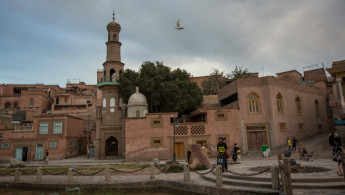China demolishes dozens of mosques, Muslim shrines in Xinjiang
China has demolished dozens of mosques and Muslim shrines in Xinjiang, the northwestern region in which an estimated one million Muslims are detained in so-called "re-education" camps, over the past three years, a new investigation has revealed.
At least 31 mosques and two major shrines underwent "significant structural damage" between 2016 and 2018, according to an investigation by The Guardian and open-source investigation platform Bellingcat.
Of those, 15 appeared to have been completely or almost completely destroyed.
Beijing has come under fire, especially over the past year, for its policies in Xinjiang, also known as East Turkestan.
Human rights groups say around a million Muslims - mostly Uighurs, but also Kazakhs and other ethnic minorities - are being detained in internment camps across the province.
Those free from detention are said to live in what is essentially a testing ground for the world's most sophisticated high-tech surveillance methods.
Muslims in Xinjiang are forced not to fast during the Muslim holy month of Ramadan, which began on Monday, and have allegedly been forced to drink alcohol and eat pork - both forbidden in Islam - in internment camps.
Investigators from The Guardian and Bellingcat identified the locations of shrines and mosques across Xinjiang with the help of former residents, researchers and crowdsourced mapping tools.
Using satellite imagery, investigators were then able to identify sites which were subject to complete or partial destruction, mostly between 2016 and 2018.
 |
Human rights groups say around a million Muslims - mostly Uighurs, but also Kazakhs and other ethnic minorities - are being detained in internment camps across the province. |  |
In addition to 31 mosques and two shrines which suffered major damage, investigators also identified a further nine sites that appeared to have been destroyed.
While previous satellite imagery of those sites did not show any of the identifying architectural features of a mosque, such as domes or minarets, previous residents had identified the sites as mosques.
Rights campaigners say hundreds - or even thousands - of mosques and shrines across Xinjiang have been bulldozed by the Chinese authorities over the past few years.
But many of those were small village mosques that lack records.
Independent researchers and journalists are routinely blocked from travelling to Xinjiang. If they are allowed to enter the region, the Chinese authorities will prevent them from getting close to the alleged locations of internment camps and other sensitive sites.
The New York Times journalists last month reported that, while working in Xinjiang, they were constantly followed by secret police.
The secret police, Paul Mozur alleged, even staged a car accident to block the journalists from traveling down one road.
Among the destroyed mosques was the almost-800-year-old Keriya mosque - completely demolished some time between late 2017 and early 2018.
An important part of Uighur Muslim culture is the visitation of shrines, and one of the most important shrines for pilgrimage in the region has for decades been the Imam Asim shrine.
Thousands of pilgrims used to trek to the shrine around this time of year.
Pilgrims have ceased to visit the shrine.
Its mosque and khaniqah (a place for Sufi rituals), as well as other buildings, have been demolished. Only the tomb of Imam Asim remains.
Investigators also say the tomb of Jafari Sidiq, another important Xinjiang pilgrimage site, has been completely torn down.
Activists say Muslims in Xinjiang have stopped going to remaining mosques altogether.
Most are equipped with surveillance systems and visitors are often required to register their IDs in order to enter.
Removing mosques and shrines from the Xinjiang landscape, activists say, is an attempt to assimilate Uighurs and other Muslim ethnic minorities into China.
If young people grow up without these remnants of their culture and faith - perhaps even separated from their family, who could be detained in internment camps - they could forget what it means to be Uighur, they say.
"If one were to remove these… shrines, the Uighur people would lose contact with earth. They would no longer have a personal, cultural, and spiritual history," Rahile Dawut, a prominent Uighur academic who worked to document Uighur shrines, said in 2012.
"After a few years we would not have a memory of why we live here or where we belong."
Dawut disappeared two years ago. Family and friends believe she has been detained.





 Follow the Middle East's top stories in English at The New Arab on Google News
Follow the Middle East's top stories in English at The New Arab on Google News

![Israeli forces ordered bombed Gaza's Jabalia, ordering residents to leave [Getty]](/sites/default/files/styles/image_330x185/public/2176418030.jpeg?h=a5f2f23a&itok=_YGZaP1z)
